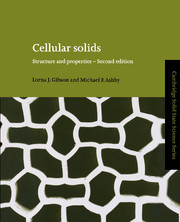Book contents
- Frontmatter
- Contents
- Preface to the second edition
- Preface to the first edition
- Units and conversion tables
- Chapter 1 Introduction
- Chapter 2 The structure of cellular solids
- Chapter 3 Material properties
- Chapter 4 The mechanics of honeycombs
- Chapter 5 The mechanics of foams: basic results
- Chapter 6 The mechanics of foams: refinements
- Chapter 7 Thermal, electrical and acoustic properties of foams
- Chapter 8 Energy absorption in cellular materials
- Chapter 9 The design of sandwich panels with foam cores
- Chapter 10 Wood
- Chapter 11 Cancellous bone
- Chapter 12 Cork
- Chapter 13 Sources, suppliers and property data
- Appendix: The linear-elasticity of anisotropic cellular solids
- Index
- References
Chapter 11 - Cancellous bone
Published online by Cambridge University Press: 05 August 2014
- Frontmatter
- Contents
- Preface to the second edition
- Preface to the first edition
- Units and conversion tables
- Chapter 1 Introduction
- Chapter 2 The structure of cellular solids
- Chapter 3 Material properties
- Chapter 4 The mechanics of honeycombs
- Chapter 5 The mechanics of foams: basic results
- Chapter 6 The mechanics of foams: refinements
- Chapter 7 Thermal, electrical and acoustic properties of foams
- Chapter 8 Energy absorption in cellular materials
- Chapter 9 The design of sandwich panels with foam cores
- Chapter 10 Wood
- Chapter 11 Cancellous bone
- Chapter 12 Cork
- Chapter 13 Sources, suppliers and property data
- Appendix: The linear-elasticity of anisotropic cellular solids
- Index
- References
Summary
Introduction and synopsis
Superficially, bones look fairly solid. But looks are deceptive. Most bones are an elaborate construction, made up of an outer shell of dense compact bone, enclosing a core of porous cellular, cancellous, or trabecular bone (trabecula means ‘little beam’ in Latin). Examples are shown in Fig. II.I: cross-sections of a femur, a tibia, and a vertebra. In some instances (as at joints between vertebrae or at the ends of the long bones) this configuration minimizes the weight of bone while still providing a large bearing area, a design which reduces the bearing stresses at the joint. In others (as in the vault of the skull or the iliac crest) it forms a low weight sandwich shell like those analysed in Chapter 9. In either case the presence of the cancellous bone reduces the weight while still meeting its primary mechanical function.
An understanding of the mechanical behaviour of cancellous bone has relevance for several biomedical applications. In elderly patients with osteoporosis the mass of bone in the body decreases over time to such an extent that fractures can occur under loads that, in healthy people, would be considered normal. Such fractures are common in the vertebrae, hip and wrist, and are due in part to a reduction in the amount of cancellous bone in these areas. The degree of bone loss in a patient can be measured using non-invasive techniques, so an understanding of the relationship between bone density and strength helps in predicting when the risk of a fracture has become high.
- Type
- Chapter
- Information
- Cellular SolidsStructure and Properties, pp. 429 - 452Publisher: Cambridge University PressPrint publication year: 1997
References
- 15
- Cited by

